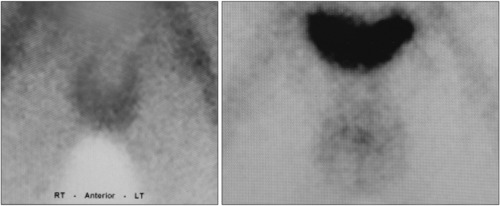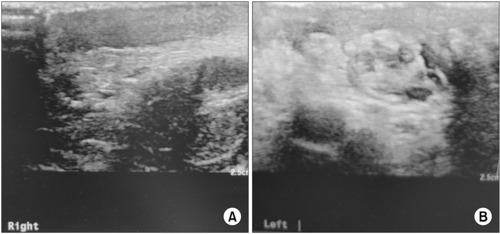Abstract
Religious beliefs are a very significant part of one’s life. We report the case of a strongly religious man who sought to remove his testicles. After enlisting in the military, the man had a surgical castration performed on him while on vacation from military service. The procedure aimed to rid the man of his libido, which he saw as a hindrance to his religious life. After the removal of the testes, his serum testosterone was 0.25 ng/ml. The luteinizing hormone, 22.1 (1.7-8.6 mIU/ml), and follicle stimulating hormone, 53.5 (1.5-12.4 mIU/ml) were elevated. Testicular scans showed an absence of both testes. This appears to be an unfortunate situation caused by false religious beliefs and the reckless use of internet resources.
-
Keywords: Castration, Orchiectomy, Christianity, Eunuchism, Military personnel
Genital self-mutilation is extremely rare. The majority of causes of self-mutilation documented in the literature are mental disorders. Castration, however, was also performed for other reasons. Throughout the history of castration, during the era of absolute monarchy, eunuchs serving the emperor were castrated to prevent sexual contact with court ladies. The church prohibited women from singing, men needed a soprano range, which was called castrati. Castration for religious reasons has been practiced for a long time. We report a case in which self-castration was performed for religious reasons.
CASE REPORT
A 22-year-old healthy Korean soldier without any comor-bidities visited our hospital on June 30, 2021. He was a devout Christian and had enlisted in the military after finishing his third year in nursing school. He had always put his religious beliefs ahead of everything else and believed that his sexuality got in the way of his religious life. Thus, he wanted to reduce his libido and arbitrarily decided that the most appropriate way to do this was to be a eunuch.
The patient decided to undergo a surgical castration and searched for orchiectomy services on the Internet. Removal of the testicles was performed at home while on vacation during his military service one month prior. He stated that he did not use anesthesia and endured the pain during the operation because of his religious beliefs. For the sutures, general needles and sewing threads found at home were used. There was significant bleeding after surgery, and he needed to stabilize his wounds for some time. After stabilization, he placed the excised testicles in a trash can in the room and returned to the unit, eventually leaving his parents to learn of the procedure.
On a visit to the military hospital, a physical examination performed on the patient revealed a 2 cm postoperative scar on the scrotum. There was a small nodule in the scrotum where the testes were previously present. The initial laboratory results of the hormone levels in the blood were as follows: follicle stimulating hormone, 53.5 mIU/ml (range, 1.5-12.4), free testosterone, 1.48 pg/ml (range, 50-200), luteinizing hormone, 22.1 mIU/ml (range, 1.7-8.6), and testosterone, 0.25 ng/ml (range, 2.01-7.50). In the additional imaging tests (radioisotope testicular scintigraphy) performed, the testicular scan showed diffuse blood pooling in the scrotal sac in the absence of both testes (
Fig. 1). Additional scrotal ultrasonography confirmed the absence of testes in the scrotum (
Fig. 2).
The patient’s mental condition during the time of this first visit was deemed to be stable via conversation. The patient was neither very anxious nor excited. He was referred to a psychiatrist for the assessment of his precise mental state and was diagnosed with an unspecified bipolar affective disorder, signaling the need for additional treatment.
Informed consent for data collection and publication of the study was obtained from the patient.
DISCUSSION
Genital self-mutilation is extremely rare [
1]. The majority of cases of self-mutilation involve a slit on the wrist, primarily carried out for attention during puberty. Self-mutilation, such as genital mutilation, castration, or eye extraction, is extremely rare. The majority of causes of self-mutilation recorded in the literature are psychiatric, such as schizophrenia, drug abuse, depression, or post-traumatic stress disorder [
2-
5]. In some cases, such an action may be unrelated to psychiatric illnesses [
6].
Throughout the history of castration, during the era of absolute monarchy, eunuchs who served emperors as their close associates were castrated to prevent sexual contact with women in the court. Some of these eunuchs wielded great power in their positions as close aides to the emperor. The system of eunuchs assisting the emperor is a bad system that has disappeared [
7].
On the other hand, if we look at the history of Western music particularly from the 16th to the mid-18th century (during the so-called Baroque era), males referred to as ‘castrati’ underwent castration before puberty to retain a high-pitched singing voice in the range of classical female singers. The castrati could sing the soprano and mezzo-soprano parts typically sung by women because the church prohibited women from singing. There were times in history when castration was very popular given that some of these castrati earned a lot of money and rose to very high positions within society [
8,
9].
Unfortunately, however, both the eunuch system and the castrato system in the courts were committed by parents and adults due to their wish to secure social status or personal advancement of the family. Among injuries to the external genitalia, those to the testes are relatively rare. In particular, most self-inflicted testicular injuries involve the self-injec-tion of poisons. Self-inflicted surgical castration without local anesthesia, as in this case, is very rare [
1].
Castration for religious reasons has been practiced for a long time. An early Christian scholar and ascetic, Origen of Alexandria, along with the Cathar sect (based in southern France from the 11th to the 14th centuries), proclaimed self-castration to be part of a pure life. More recently, castration has been practiced among members of a Skoptsy sect founded in the 18th century in southern Russia, the medical consequences of which have been documented. The largest modern castration group comprises the Indian hijras, made up of people with sexual developmental disorders. They serve as professional fortune tellers in birth ceremonies and weddings and receive significant monetary rewards. Thousands of such practitioners exist [
10].
According to an oriental classic, since our bodies, bones, and skin are all received from our parents, it is an aspect of filial piety to preserve them, so that they are not damaged or injured. It contains the profound meaning that it is the end of filial piety and filial piety to parents as a child, to reveal oneself to future generations while living properly.
Although religious beliefs are sometimes regarded as an important part of one’s life, a fanatical belief can lead one astray. An impatient act based on such a belief carried out among younger age groups living in a flood of information can have irreversible consequences.
NOTES
-
CONFLICT OF INTEREST
No potential conflict of interest relevant to this article was reported.
-
FUNDING
No funding to declare.
-
AUTHOR CONTRIBUTIONS
S.G.C. participated in data collection. K.H.Y. wrote the manuscript. All authors read and approved the final manuscript.
Fig. 1Radioisotope testicular scinti-graphy showed no uptake of isotope in the bilateral scrotum. Normal isotope uptake of the testes is not seen.

Fig. 2(A, B) Scrotal ultrasonography showed no testes in the bilateral scro-tum.

REFERENCES
- 1. Garofalo M, Colella A, Sadini P, Bianchi L, Saraceni G, Brunocilla E, et al. Management of self-inflicted orchiectomy in psychiatric patient. Case report and non-systematic review of the literature. Arch Ital Urol Androl 2018;90:220-3. ArticlePubMedPDF
- 2. Stunell H, Power RE, Floyd MS Jr, Quinlan DM. Genital self-mutilation. Int J Urol 2006;13:1358-60; Erratum in: Int J Urol 2017;24:820. ArticlePubMed
- 3. Rao KN, Bharathi G, Chate S. Genital self-mutilation in depre-ssion: a case report. Indian J Psychiatry 2002;44:297-300.PubMedPMC
- 4. Charan SH, Reddy CM. Genital self mutilation in alcohol withdrawal state complicated with delirium. Indian J Psychol Med 2011;33:188-90. ArticlePubMedPMCPDF
- 5. Ahsaini M, Tazi F, Khalouk A, Lahlaidi K, Bouazzaoui A, Stuur-man-Wieringa RE, et al. Bilateral testicular self-castration due to cannabis abuse: a case report. J Med Case Rep 2011;5:404. ArticlePubMedPMCPDF
- 6. Mareko GM, Othieno CJ, Kuria MW, Kiarie JN, Ndetei DM. Body dysmorphic disorder: case report. East Afr Med J 2007;84:450-2. ArticlePubMed
- 7. Nieschlag E, Nieschlag S. Testosterone deficiency: a historical perspective. Asian J Androl 2014;16:161-8. ArticlePubMedPMC
- 8. Melicow MM. Castrati singers and the lost "cords". Bull N Y Acad Med 1983;59:744-64.PubMedPMC
- 9. Jenkins J. The voice of the castrato. Trans Med Soc Lond 2001;118:37-42.ArticlePubMed
- 10. Wilson JD, Roehrborn C. Long-term consequences of castra-tion in men: lessons from the Skoptzy and the eunuchs of the Chinese and Ottoman courts. J Clin Endocrinol Metab 1999;84:4324-31. ArticlePubMed
Citations
Citations to this article as recorded by

 , Sung-Goo Chang1,
, Sung-Goo Chang1,


 , Department of Urology, Armed Forces Capital Hospital, 81 Saemaeul-ro 177beon-gil, Bundang-gu, Seongnam 13574, Korea, Tel: +82-31-725-6247, Fax: +82-2-440-7744, E-mail: sg2chang@gmail.com
, Department of Urology, Armed Forces Capital Hospital, 81 Saemaeul-ro 177beon-gil, Bundang-gu, Seongnam 13574, Korea, Tel: +82-31-725-6247, Fax: +82-2-440-7744, E-mail: sg2chang@gmail.com 




 KAUTII
KAUTII

 ePub Link
ePub Link Cite
Cite

